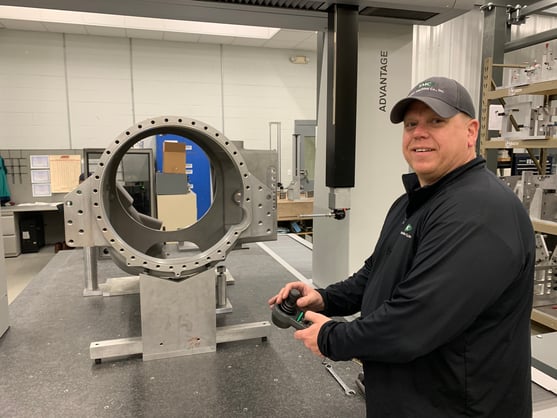QA, PPAP, APQP, CMM, PSW, etc. Wow, the world of quality assurance is an alphabet soup of abbreviations.
This article explains many of them and, more importantly, explores how each is vital to the quality assurance process when it comes to parts manufacturing. It also addresses how a focus on quality gives one leading CNC (another abbreviation!) machine shop a distinct advantage, especially when running several concurrent projects.
First, a reminder that computer numerical control (CNC) machines absolutely are relied on for quality in the machining industry. They cannot achieve the needed precision, speed, and repeatability without incredible quality control.
So, what is quality? A combination of design, processes, and culture, quality can’t be “tested in” to a product or process. A dedicated manufacturing quality assurance (QA) team leads the charge to ensure that the combination is not only capable, it results in a product that is reproducible.
Yes, CNC machining results in far fewer errors than manual processes, yet they still occur. Effective quality assurance only happens through a proven process, including the part production approval process (PPAP), which requires specific steps and a concentrated effort from the QA team. Here’s how it works …
Step 1: Part Production Begins with Design Review
With a purchase order (PO) and final drawings approved, the QA process formally begins with the print review. Is the customer design manufacturable? Are specified tolerances achievable? Is the current measuring equipment capable of checking all features on the print accurately?
Now, the QA and engineering teams begin the advanced product quality planning (APQP) process. For new designs, additional upfront work may be needed by both teams, who work hand-in-hand with customers and foundry suppliers on new parts. Together, they review the design and manufacturing processes to optimize product function and minimize costs.
Step 2: Quality Leads Production for a Smooth Launch
The APQP process is ongoing as the engineering team designs fixtures, creates programs, and chooses tooling, while the QA team performs analysis and creates checks to verify engineering and production. Both teams work together toward the common goal of accurate production and satisfied customers.
Several tools are used to analyze, control, and document production, including:
- Product Control Plan (PCP) — lists all customer specifications, the manufacturing process steps, and quality controls at each process step
- Failure Modes Effect Analysis (FMEA) — used to understand the manufacturing process and controls, plus minimize defect risks
- Process Flow Diagram (PFD) — outlines the manufacturing process for inspections
These are the most important deliverables:
- First Article Inspection (FAI) — defines all the specifications; checked each time a new job is set up to produce the part
- Operator Audit Sheet (OAS) — lists all the checks the operator completes during production
- New gauges are ordered as needed
- Coordinate-Measuring Machine (CMM) — quality control/audit program that verifies positions and features
- Supplier Quality Requirements (SQR) — makes sure any questions and issues are communicated and worked through
- Engineering designs are reviewed by a Quality Engineer (QE)
Step 3: Production Samples
The first production sample gets special attention. After production sets up the job and runs the first piece, the operator completes the FAI, and the part is brought to the QA team who proves out the CMM program.
The QA team works with the operator and engineering if any features are:
- Out of tolerance — The need is a 5" diameter bore with a tolerance of +- 0.001". If the bore is 4.9980”, it is too small and out of tolerance.
- In tolerance but off of nominal — For the same 5" diameter bore, the cut is consistently 4.9991”, 4.9992”, 4.9991”, etc. The goal is to get this dialed closer to 5.000” +- 0.0002” (not 4.9992” +-0.0002”).
After a part passes the FAI and CMM checks, an Initial Sample Inspection Report (ISIR) is completed, which includes a full dimensional layout of the part to verify print specifications. Plus, each dimension on the drawing is measured and recorded.
Next, QA signs off, and the PPAP begins (that’s the “part production approval process,” in case these abbreviations are confusing you.) Numerous production samples are produced (typically 30 pieces), and three are checked for ISIR (the first piece plus two more samples, typically taken from the middle and end of the run).
Step 4: Part Submission Warrant (PSW)
After the samples pass the ISIR and are complete, a part submission warrant (PSW) is finalized and submitted. The samples are used to measure the process capability (Cpk); a process’s ability to create a product within specification limits. At this point, gauge repeatability and reproducibility (GR&R) is measured, ensuring a gauging instrument’s accuracy.
The entire PPAP documentation package is then completed and submitted with a signed PSW.
The Quality Team Is Key in New Part Production
Too often the quality assurance process in parts manufacturing is seen as “quality assurance vs production,” but those two can (and should) be complementary. Quality should not hold up production.
An experienced QA team balances those two goals in a smooth PPAP launch. Stecker Machine’s 20-member team includes auditors, technicians, engineers, programmers, and a systems coordinator. The team covers various specialties, but all work together to ensure production happens to customer specifications.
Recently, Stecker Machine launched several new parts concurrently, putting the QA team to the test. The timeline was tight, resources were carefully managed and aligned, and several people stepped up to complete the many ISIRs with full dimensional layouts. A schedule and manpower bottleneck was handled by CMM programmers, technicians, managers, and even a machinist apprentice.
For this project, Stecker Machine’s three CMMs used for FAI parts (another seven are for in-cycle parts) expanded to a fourth CMM. That required adjusting the production sampling plan, mainly by determining production parts that were stable and could be tested less frequently. There was no increase in production scrap, and the schedule remained unchanged.
With a little creativity and a lot of hard work, Stecker’s QA team produced over 30 new parts concurrently while maintaining quality. That drive and focus ultimately resulted in meeting (and exceeding) customer needs.
Ready to put Stecker’s machining and quality to the test? Reach out with an RFQ (the last of this article’s abbreviations!) Contact Stecker or call 920-726-4526. Not ready yet? Read this case study on a recent machining, testing, and quality challenge






